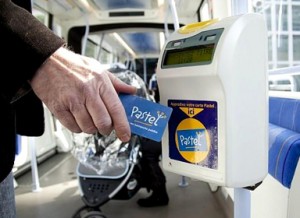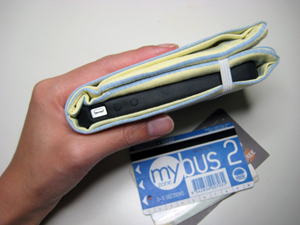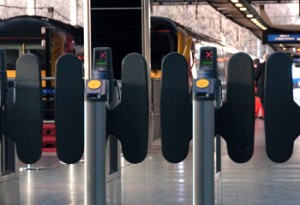An exploration into the emergence of a phenomenon that is being hailed as A snapshot of a study of the many challenges lying ahead for the European transport system in terms of a Single European Transport Area, with the goals set to be achieved by 2050 for transportation to become more competitive and resource efficient regarding smart ticketing and its multi-modal potential for integration with other services
by Urban ITS Expert Group, European Commission
 Nowadays, there are a number of challenges lying ahead for the transport system. The idea of a Single European Transport Area, promoted by the European Commission’s White Paper for Transport 2011, sets the goals to be achieved by 2050. Transportation has to become more competitive and resource efficient within this time horizon.
Nowadays, there are a number of challenges lying ahead for the transport system. The idea of a Single European Transport Area, promoted by the European Commission’s White Paper for Transport 2011, sets the goals to be achieved by 2050. Transportation has to become more competitive and resource efficient within this time horizon.
The goals for urban transport, in this respect, are to promote the use of cleaner cars and cleaner fuels. There is also a need to reduce the number of fatalities. Yet another challenge is that the amount of traffic in Europe’s urban areas has been increasing inexorably during last decades. The task of people involved in urban traffic management is to best allocate the scarce resources of road and kerbside space to potentially competing transport modes, within a network that has a finite capacity.
Smart technologies and Intelligent Transport Systems (ITS), in particular, have a role to play in achieving the aforementioned goals. ITS can significantly contribute to a cleaner, safer and more efficient transport system, especially in urban areas. The ITS Directive (2010/40/EU) gives the legal framework in order to accelerate the coordinated deployment of innovative transport technologies across Europe. It aims to establish interoperable and seamless ITS services while giving Member States the freedom to decide which specific systems to invest in.
Resulting from these provisions, the Expert Group, ITS for Urban Areas, was set up, in order to support the European Commission in its work concerning the aforementioned Action Plans. The tasks of the Expert Group have been three-fold: to provide guidance on ITS deployment in urban areas, collect Best Practices on successful deployment and identify a possible need of Standardization. The group had to develop specific guidelines to promote and show the benefits of the use of ITS in urban areas along the individual travellers’ mobility chain. The Guidelines despite the fact that they do not have mandatory character have the aim to foster interoperability and continuity of services within Europe.
The guidelines target the organizations in charge of decision making and technical deployment of ITS on local level. Separate studies were carried out for each key application of urban ITS – traffic and travel information, smart ticketing and traffic management and urban logistics.
Smart ticketing
Smart ticketing has been a topic for over a decade now, but what does the term ‘smart’ mean in this context? When using this term, we are generally talking about new technologies and integration of services not directly linked to the basic functions of tickets. The main issues of smart ticketing are:
- propose complementary services to users in relation with their mobility
- modify relationship between public transport user and his/her ticket as also between public transport operator and its tickets
- improve overall efficiency and image of Public Transport network as also the depth of data created through usage.
 Smart ticketing could permit to contribute to the overall improvement of the public transport network level of services, image, accessibility, with the main aim to facilitate and/or increase the use of public transport and so contribute to the overall political goal of developing a sustainable transport policy. This though, is not necessarily about having one ticket for your journey but having one wallet for several tickets.
Smart ticketing could permit to contribute to the overall improvement of the public transport network level of services, image, accessibility, with the main aim to facilitate and/or increase the use of public transport and so contribute to the overall political goal of developing a sustainable transport policy. This though, is not necessarily about having one ticket for your journey but having one wallet for several tickets.
There are a number of potential implementation choices within the guidelines for smart ticketing:
- using a dedicated application
- based on the virtualisation of tickets
- based on secure identity and back-office processing
One of the main trends that could be extracted with the development of smart ticketing is that we are more and more personalizing the ‘ticket’, the contract used by the final user. The differing needs (and ‘ways of consuming’ i.e. PT services shall be seen as a consumer good and sold/marketed as such) of groups or communities of people are becoming a challenge for the implementation of the Transport and the Fare Policies.
Stakeholders needs
Implementing smart ticketing also means thinking of the stakeholders and their needs, therefore how to respond to these needs and elaborate marketing accordingly. To date, the main stakeholders are clients, politicians and authorities, public transport operators, scheme providers, suppliers, payment industry, media and lobbies. Specific focus should be paid to the final user’s needs (easiness, simplicity and fairness), public policy needs (shift in modal split reducing car travel, reduction of pollution, optimization of operational efficiency, reduction of public expenses) and the transport operator’s needs (reduce operational costs of ticketing, improve fare collection efficiency, improve knowledge of customer’s behavior/choices/preferences).
It is also important to recognize the trends and act appropriately. The trends in ticketing can be specified as ‘from magnetic to contactless’, ‘from cash to smart payment’, ‘from in-house/on the field sales channels to externalized/remote ones’, ‘from mono-application to multi-application devices’, the ‘impact on infrastructure itself’ and the ‘impact on fare evasion’.
 Smart ticketing should have an impact on the way public transport is used. Using a ticket, or wallet, not only for transportation but for mobility services in general could improve the image of public transport. Access to fare information and easier remote sales will also help the cause, whereas privacy concerns must be addressed in a code of conduct to be able to develop a trust relationship with customers.
Smart ticketing should have an impact on the way public transport is used. Using a ticket, or wallet, not only for transportation but for mobility services in general could improve the image of public transport. Access to fare information and easier remote sales will also help the cause, whereas privacy concerns must be addressed in a code of conduct to be able to develop a trust relationship with customers.
The development of smart ticketing in a global urban ITS perspective has to be built in respect to local organizations and to the decentralized nature inherent to public transport and to the importance of its public funding.
ITS recommendations
The recommendations to deploy are therefore:
General – smart ticketing should not be seen as a simple replacement for traditional paper or magnetic ticketing. An important step is identifying which features and functionalities of smart ticketing can be adopted and how they will integrate with the customers’ wider mobility requirements. Its introduction is also an opportunity to rethink the current fare policy and to offer additional/alternative fare possibilities to customers.
Business models – smart ticketing is a global business and is, for the first time, being driven by standards. This allows off-the-shelf technology to be adopted with only limited local tailoring to reflect specific tariff structures and cross-modal opportunities. By using open international standards for smart ticketing, public transport operators can access supply chains that are responsive, cheaper and address industry best practice.
Distribution channels – smart ticketing must allow passengers to plan and book their travel through their choice of distribution and retail channels. This goal required a new system that can accommodate the speed, power and flexibility necessary to handle multiple distribution channels for ticket sales, including contactless payment and pre-loaded value.
Smart wallets – smart ticketing covers not just pre-payment and the loading of a ticket onto the smartcard or phone, but can also include post-payment where the customer is identified on entering / leaving a closed system and verified that they are authorized to travel or have suitable payment mechanism available (whether that is a contactless bankcard or pre-arranged credit). A smart wallet also gives the opportunity to integrate other services whether transport related (e.g. bike or car sharing, parking), associated (e.g. tourism information) or non-transport related (e.g. shopping, use fees).
Marketing issues / public support – urban ITS decision makers should now systematically look for integration in such wider organizations to take benefit from the mutualization of standard technical tool boxes as well as to insert their customer offer in a wider market.
Organizational and legal issues – urban and national transport decision makers must actively support the development and implementation of European and international specifications to ensure mutual compatibility between all schemes.
Integration with travel information and traffic management – by creating a linkage between travel information, journey planning, payment and smart ticketing, including a liaison with compatible mobile phone and contactless bankcard schemes in Europe, smart ticketing can ensure the customer experience consistently meets their highest expectation. As a result this can foster co-modality/intermodality. Interoperability in transport implies removing the obstacles for the customer to switching transport modes. All ticketing needs for through journeys should be in one place and on their local transport smart ticketing media, even outside their home network. There should be simple registration processes in place so that the customer has a standardized machine interface and easy access in his/her own language.
Development of standards – the use of international and open standards can facilitate interoperability, the opening of global markets and compatibility between devices produced by different suppliers.
Data privacy – protection of the customer’s privacy is an ethical requirement of confidentiality, un-linkability, un-observability and anonymity. A low level of protection not only could be punished as a violation of the law but would damage customer acceptance.
Fare management
A few years ago, the main objective of a ticketing system was firstly to organise the collection of public transport fares, while secondly to control and try to reduce fraud on the public transport network.
A first fundamental statement would be that a ticketing system (being smart or not) is only the tool that would permit the implementation of public transport fare policy at the level of the whole public transport network. Therefore, there is a need of an overarching authority and a clear code of conduct (in turn this authority could delegate power to sub stakeholders / consortium / operators depending on the tasks to be undertaken). The definition of fare policy is a real condition within the specification and the development of the associated ticketing system.
Application concepts
There are a number of potential implementation choices to be decided, also taking into account how it applies to urban mobility.
Dedicated application
Smart card will be on top of the list, as it is probably the one which has now been developed the furthest in Europe. Note that it could, but need not to be contactless. USB Keys or Dongles are also means of support that are used on some networks, based on a contactless communication for the validation. More recently, the use of NFC applications (loaded onto mobile phones) has been developed and is considered as a promising solution for the future.
Virtualization of tickets
It would use the concept of electronic tickets that could be printed with a security based barcode. Because a barcode can be copied easily, it is normally restricted to use for long distance trips involving a dedicated seat reservation.
Secure identity and processing
Here the customer is identified on entering the transit system by means of the identity number of a smartcard, a government issued ID Card, contactless bankcard or secure tag. The customer either prearranges credit or a period pass / carnet to be associated with the secure identity, or the identity is associated with a method of payment as is the case with a contactless bank or credit card.
There are two main issues have been developed and explained in a recent paper by the Urban ITS Group and that illustrate the difference between the above-mentioned three categories of smart ticketing. These are:
- in the first and second category, the front-office process will be more developed; specific efforts will be necessary to ensure security, especially when working on the services integration
- in the third category, the main ‘efforts’ will have to be put on the back-office treatment and the relation with the final users in the front office will be reduced as the support is not under the responsibility of the transport retailer.
